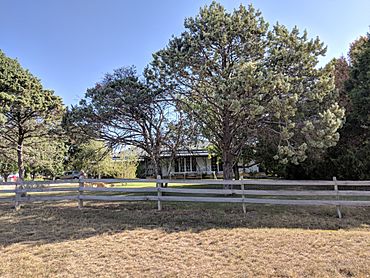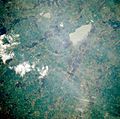Currawang facts for kids
Quick facts for kids CurrawangNew South Wales |
|||||||||||||||
|---|---|---|---|---|---|---|---|---|---|---|---|---|---|---|---|

House in Currawang
|
|||||||||||||||
| Postcode(s) | 2580 | ||||||||||||||
| Elevation | 814 m (2,671 ft) | ||||||||||||||
| Location | |||||||||||||||
| LGA(s) |
|
||||||||||||||
| Region | Southern Tablelands | ||||||||||||||
| County | Argyle | ||||||||||||||
| Parish | Currawang | ||||||||||||||
| State electorate(s) | Monaro | ||||||||||||||
| Federal Division(s) | Eden-Monaro | ||||||||||||||
|
|||||||||||||||
Currawang is a quiet rural area in New South Wales, Australia. It is located north of Lake George. This area is special because it sits where three different local councils meet: the Queanbeyan–Palerang Regional Council, Goulburn-Mulwaree Council, and a small part in the Upper Lachlan Shire. The name Currawang comes from an Aboriginal word. It means "spearwood tree," which is a type of tree called Acacia doratoxylon.
Contents
Discovering Currawang's Past
First People of Currawang
The land of Currawang was first home to the Gundungurra people. They called this area Werriwa. They lived here for thousands of years.
Early Settlers Arrive
Around 1824, one of the first European settlers, Francis Kenny, received land here. His land was near a spot still known as Kenny's Point. This point is on the northern shore of Lake George.
By the mid-1840s, more land was given out in the Currawang area. A post office opened at Kenny's Point by 1859. A school also started there in 1867. Soon after, people discovered copper and gold nearby. This led to the growth of a small town called Currawang.
Mining for Metals
A company called the Currawang Copper Mining Company started in 1865. They mined copper, and the ore was very rich. They even found small amounts of gold and silver. The company built a smelter to process the ore. This smelter used wood from local trees as fuel.
However, the mine faced money problems and closed in 1868. It later reopened as the Phoenix Mine. This new mine worked well for a while. But by 1882, the copper ore became harder to find. So, the mine closed again.
People tried to restart mining several times. More ore was found in 1896, but the new company closed quickly. In 1907, the Collins Brothers bought the mine. There were plans to build a new furnace. This furnace would reprocess old waste, but it never happened.
Later attempts to mine or reprocess waste in the 1920s and 1930s failed. The last mining activity was a search for uranium in 1948. This search was not successful.
The mining left the land damaged and polluted. Runoff water from the mines flowed into Lake George.
Modern Mining Efforts
In the 1980s, a large mine called Woodlawn Mine operated nearby. In 1987, they found a new deposit of lead, silver, and zinc ore in Currawang. This ore was taken to the Woodlawn operation. About 500,000 tons of high-quality ore were extracted in the mid-1990s.
As part of this work, a large dam was built. It helped to divert water away from the old and new mine sites. The old mining areas were cleaned up. Waste was put into a pit and covered with clay. This helped to heal the land.
Life in the Mining Town
The mining town of Currawang grew quickly. It was built on private land, but a public road served it. The houses were spread out near the mine and smelter. It seems the town never had proper streets. Yet, its population might have reached 2,000 people in the 1860s and 1870s.
The town had a post office, shops, and a primary school. There were also two churches. In 1876, Currawang had about 50 houses. It also had four stores, a blacksmith, and two hotels. One hotel even held Catholic church services. There was even a brewery!
The post office opened in 1866. The Currawang Public School operated from 1870 to 1944. It closed because fewer children lived in the area. Many miners were from Wales and were Methodists. When mining slowed down, many left Currawang.
By 1948, the town had almost disappeared. Only the post office, a small telephone exchange, and the churches remained. The post office closed on March 31, 1962.
The Village of Murray
In the southern part of Currawang, another town was planned. In 1886, a spot was set aside for a village called Murray. It was on the northern shore of Lake George. This village was likely named after Terence Aubrey Murray. His property was nearby.
The village was surveyed, and land was put up for sale in 1887 and 1910. However, the village never really grew. Its plan was cancelled in 1919.
Currawang Today
Thanks to the cleanup work, you can't see much evidence of the old mines today. Currawang is now a beautiful rural area. Even though there's no mining, people are still interested in finding minerals here.
Farming is still the main activity in Currawang. But jobs also come from waste management facilities. These facilities reuse the old mine sites. The recently built Capital Wind Farm also provides employment. There is also an active Rural Fire Service Brigade.
Today, the main buildings left are the Catholic church (St Laurence O'Toole) and the Anglican church (St. Matthias). Both have cemeteries. St Matthias still holds services every three months. Its churchyard cemetery is still used for burials.
Picnic Point, on Lake George, got its name from the miners. They used to have picnics there when the mines were busy.
Images for kids
-
Lake George from space, November 1985
-
1840s map of the County of Argyle








